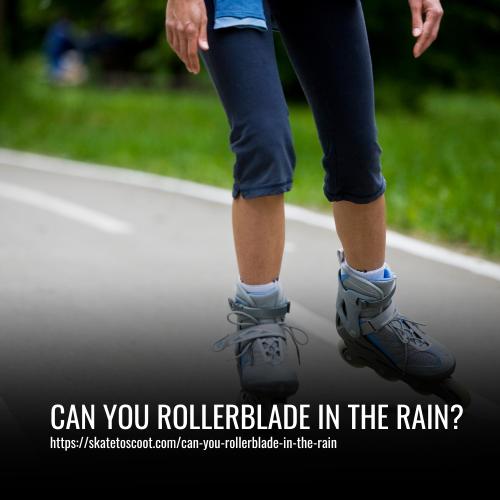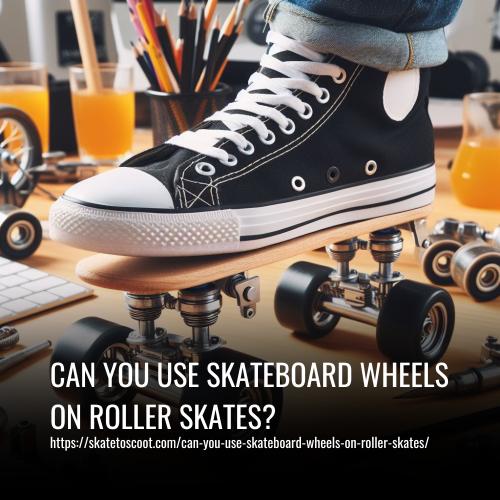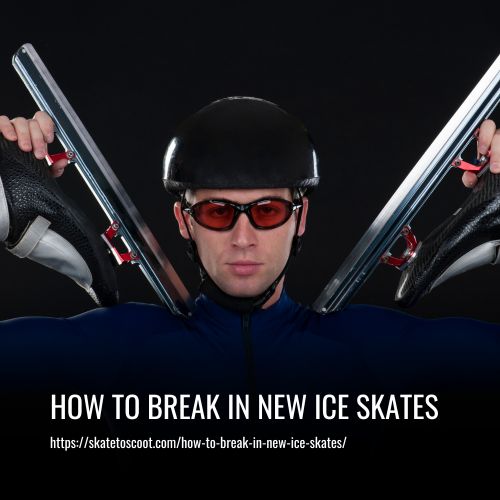As an Amazon Associate we earn from qualifying purchases.
Rollerblading in the rain is not recommended. Wet surfaces can make it difficult to maintain balance and control, increasing the risk of accidents and injuries. Additionally, water can damage the bearings and other components of rollerblades. It is best to wait for dry conditions before rollerblading.

Risks and Challenges of Rollerblading in the Rain
Here are some risks and challenges of rollerblading in the rain:
1. Wet Ground And Slippery Surfaces
Skating on wet surfaces poses a unique challenge due to the sheer amount of slipperiness. This can be especially true for inline skate wheels which create tilting when you roll and have a curved profile.
Even surfaces that are smooth and polished in the dry will become much more slippery when it’s wet, making it difficult to predict what conditions will be like ahead of time.
Stones, marbles, and indoor floors tend to be some of the most slippery out there, so exercise extra caution when skating on them in wet conditions.
2. Skating Strides Will Become Harder to Manage
Skating in the wet can be challenging for even experienced skaters, as it’s much harder to create the usual propulsion when you’re pushing out to the side. Without a proper stride, you might find yourself slipping, which can throw off your balance and make it easier to fall.
Another problem faced while skating in the wet is pronation on a slight inside edge. This has to be controlled carefully so that when the pushing skate regroups in the center, it must be placed on an upright and centered edge – this is crucial for a safe glide over wet surfaces.
An upright wheel needs more effort but cannot slide unexpectedly, so controlling your stride is an essential challenge of skating in the wet.
3. Difficulties When Trying To Stop
Stopping is one of the biggest challenges for skating in wet conditions. With regular methods of transport, the stopping distances are longer in damp weather, and this is true for skates as well. It can take up to three times longer to stop when skating on wet surfaces than it does on dry ones.
For veteran skaters, the best way to stop while in rainy weather conditions is those involving sliding one skate, such as T-Stop, Powerslide, or Soul Slide. However, these sliding methods require impeccable balance since they will slide further before actually stopping you.
Additionally, parallel slides, hockey stops, and magic slides become much more difficult to control on slippier surfaces, so it’s best to proceed cautiously with them if you’re skating in wet conditions.
On the other hand, beginners should rely on heel brake stops for non-sliding stops because the rubber brake will slow and stop you without risking a slip but know that it will take more time during dampness than usual.
4. Turning Becomes A Hurdle
Turning is one of the biggest challenges for skaters in wet conditions. Typically, turns involve edging and crossovers which require body rotation – both of which can lead to a disaster in wet conditions. With damp surfaces, it’s important to drastically reduce your speed when taking a turn so as to ensure your safety.
Additionally, look out for any color irregularities on the surface that indicate where the damp patches could be – this can help you avoid any potentially dangerous turns.
When skating in the rain or wet conditions, it’s best to minimize edging and crossovers until you’re sure that you can do so safely with reduced speed.
5. You Could Damage Your Equipment
Equipment is one of the biggest challenges to consider when skating in wet conditions. It’s important to keep your skate bearings clean and dry, as moisture can affect their performance. If you are using normal wheels during wet skates, the durometer will have a significant effect on your grip.
Harder wheels don’t offer as much traction, while softer ones provide more stability. For this reason, having a dedicated set of rain wheels is an excellent option – they will allow you to take advantage of extra grip no matter how wet it gets!
How to rollerblade in the rain
Rollerblading in the rain can be a fun and exhilarating experience, but it is important to take necessary precautions. Here are some tips for rollerblading in wet conditions:
1. Adapt your stride
When rollerblading in the rain, it is important to adapt your stride and skate slower than normal. To ensure stability and maintain control, strive for a shorter stroke with a faster cadence.
Before you start skating, take a moment to make sure your feet are properly positioned; if you pronate on your gliding foot, it can cause sliding or an accidental fall. Balance is key here; stay centered over your glide skate with both wheels upright on the center edges.
It’s also important to keep in mind that this higher, faster tempo of skating can be more tiring than usual. Your body will undoubtedly be more tense due to the higher risk of sliding or falling in wet conditions.
Therefore, always look ahead often, as prevention is much better than reaction if something goes wrong. With these tips in mind, you’ll be ready to safely and confidently rollerblade through even the rainiest weather!
2. Stopping adjustments
It is important to adjust your stopping techniques accordingly when rollerblading in the rain. For experienced skaters, slides like the T-Stop, Powerslide, and Soul Slide, are great because they allow you to put more of your weight on one skate while sliding the other.
To stay balanced and stable during a slide, ensure your support skate is on the center edge, with the wheel straight up and not at an angle. For beginner skaters who don’t yet have the balance needed for the advanced sliding stops, it is better to stick with using the heel brake and leaving extra space in case of longer stopping distances.
Practicing these slides in wet or damp conditions can be good training as you will get more of a slide than compared to when skating on dry ground.
Remember that when skating on wet surfaces it is best to reduce speed and leave extra room for longer stops. Additionally, avoid stops involving turns as it can be very difficult to prevent an unexpected slide from happening. With these adjustments made, you’ll be able to enjoy safe rollerblading regardless of rain!
3. Turning adjustments
Turning in the rain requires special adjustments to ensure your safety. For larger turns, make sure that you open up your skates by taking short strides, as this will help disperse impact on the inside of the turn.
When damp surfaces are present, avoid using the parallel turn, lunge turn, or crossovers until you have trained and developed a sense of safety and comfort in wet conditions.
The parallel turn can be learned without tilting your wheels onto their edges but it is not recommended for beginners because it requires lots of practice and focus to do so safely.
To properly do a parallel turn while keeping your wheels off the edges, shift your weight from the balls of your feet towards your heels so that the front wheels become lighter. This way, you can guide them around the turn without needing to use edge work.
However, be aware that sharp turns with this technique won’t be possible – slower speeds with bigger turns should give you better chances at success!
4. Up and down slopes
Going up or down slopes on rollerblades in the rain can be quite dangerous. It takes more effort to skate up a slope in damp conditions as only shorter strides are possible and the cadenced rhythm needs to be increased. To minimize risks, try to avoid all the surface obstacles and skate around them instead.
When going down a hill, try not to gain too much speed. Preferably start from the bottom of a hill and work your way up gradually until you reach the top. If that’s not possible, begin very cautiously with regular brake pressure applied by either braking or sliding techniques like T-stop or soul slide.
Be aware that even applying a sliding method may cause acceleration due to a lack of traction on slippery ground – so make sure to stop and reassess your situation in this case.
Depending on the gradient and surface of the hill, there will always be some slopes that are unsafe to go down in wet weather, even for intermediate-level skaters.
5. Roller Blading In a Straight Line
Skating in the rain can become quite a challenge due to the wet pavement. Your feet won’t be able to slide apart and maintain stability, so it’s important to keep them as close together as possible.
Furthermore, your ability to skate in low friction conditions will be diminished, so it’s best to push down on your skating instead of pushing sideways. In order to skate in a straight line when it’s raining, you should make sure that you have short and smooth strides.
Additionally, try not to use too much pressure with your movements or go too far outwards when skating. These adjustments will help you remain balanced and give you more control over where you’re headed!
6. Wear Protective Gear
When rollerblading in the rain, it is essential to wear protective gear. A helmet can protect your head from any falls while knee and elbow pads can provide reliable cushioning should you slip during the ride.
Wrist guards are also important, as they can help prevent any serious injuries in case of a slip or fall. You should also consider getting a hip pad for extra protection for your bottom region.
It’s just as imperative to be aware of potentially slippery surfaces like pools of water when skating in the rain. Potholes or other deep sections of a wet road could lead to an increased chance of slipping and getting injured.
To ensure your safety, stay away from these areas whenever possible. For best results, make sure that you have all the necessary protective gear when you go rollerblading in wet conditions!
Safety Tips When Rollerblading in the Rain
Here are some tips to keep you safe when rollerblading in the rain:
1. Get Your Blades ReadyBefore Going Out In The Rain
Before going out into the rain, it’s vital to make sure your skates are ready. This means ensuring that the bearings are working properly so that the wheels can spin easily, as well as making sure you have the right kind of wheels installed.
Harder wheels like those with a grade of 85A and up may slip on wet surfaces, so opting for softer wheels with good grip is key. Wheels specifically designed for rainy conditions, like those offered by Labeda and MPC, would be the best option here.
You’ll also want to make sure you keep your feet dry through boot covers such as those made by Ezeefit. While these covers won’t do much for your wheels’ traction in wet areas, they will keep your skate boots nice and dry!
2. Look out for Dangerous Surfaces
When rollerblading or skateboarding, be sure to look out for white lines and dangerous surfaces such as cobblestones, marbled ground, and autumn leaves. White lines can be particularly slippery, so it’s best to avoid them altogether if possible.
Cobblestones can also pose a risk, but if you spread your feet a bit to help absorb the bumps and keep your speed slow it should be safer. The marbled ground is super dangerous – you don’t want to push out to the side or make any sharp turns. Stay centered and go straight instead.
Lastly, autumn leaves can hide various hazards so control your speed and keep weight stabilization while turning. Be extremely careful when skating across these surfaces!
3. Use Special Rain Wheels
If you plan on rollerblading in the rain, it’s important to have the right kind of wheels. Harder wheels with a rating of 85A and higher should be avoided for wet and slippery surfaces, as they don’t offer much grip.
The most suitable option is soft wheels with a 70A grade – this will help you stay safe while rollerblading in the rain.
4. Stay Low in the Recommended Skating Position
If you’re planning to go rollerblading in the rain, always make sure to keep your body low and in the recommended skating position. This ensures that your body weight is distributed throughout your skates – making it easier to stay balanced and maintain control over your blade.
It’s very important that you have bent knees over the toes and shoulders above your hips to make sure that you have enough stability.
Even if you’re not an experienced rollerblader, learning this skill before you hit the roads will be extremely beneficial. It might feel a little uncomfortable at first, but trust me – mastering the correct skating position is worth all the effort!
5. Avoid Pools of Water on the Road or Pavement
When rollerblading in the rain, it is highly important to avoid pools of water on the roads or pavements. Even though they may look harmless and shallow, they can actually be a lot more dangerous than you think.
Pools of water may conceal perilous potholes that can cause serious injury to your skates and lead to broken bones in your feet if you skate over them.
6. Avoid Longer Pushes and Glides
When rollerblading in the rain, it is important to be mindful of longer pushes and glides. Doing this on a wet surface can be dangerous as it puts your safety at risk. This is why I suggest taking smaller strides when making your way to your destination.
If you have special rain wheels, you don’t need to worry about long pushes and glides as much, but it’s always best to practice caution. That way, you can arrive at your destination in one piece!
7. Maintain Low Speed and avoid doing Tricks
The key to staying safe while rollerblading in the rain is to maintain low speed and avoid doing tricks. Skating too fast on slippery surfaces leads to disastrous results that you don’t want to experience. Even if you are a professional skater, it’s advised to keep your skating simple and focus on reaching your destination safely.
If you do choose to do tricks, make sure you plan them thoroughly and adjust your speed accordingly. By following this advice, you’ll be able to rollerblade in the rain without having an accident!
8. Clean Roller Blades, Wheels, and Bearings after Use
After skating in the wet, it is vitally important to clean your bearings immediately. Water and mud can cause long-term damage to every metal part of your skates – lace eyelets, buckles, axles, and especially bearings – as the water can cause them to rust within hours.
To avoid this kind of disaster, it is best to take apart your skates and clean all components that have come into contact with dirt or water.
The first step in cleaning your bearings is unscrewing them from their components. Next, you should wash them with rubbing alcohol which will remove both water and lube. Once they are sufficiently dry be sure to relube them immediately as this is essential for reliability under any conditions.
Additionally, it is wise to remove the wheels from their frames as this will help keep the bolts, axles, and nuts from also rusting together.
In situations where time is short submerging the bearings in oil (even baby oil) works well for displacing both water and air so that rust formation is delayed. When done properly you can even transfer them into a Zip Lo baggie after some time in the oil bath!
As a last resort, bearings can be submerged in water but understand that there are more effective methods available for keeping them dry and rust-free for longer periods of time.
FAQs
Rollerblading in the rain is generally not recommended. Wet surfaces pose significant risks as they reduce traction, potentially causing you to slip or lose control. Additionally, water can damage the bearings and other components of your rollerblades.
While some rollerblades claim to be waterproof or water-resistant, it’s crucial to note that even these might not provide complete protection in heavy rain. The bearings and other parts are still susceptible to water damage.
Avoiding rainy conditions is the best way to protect your rollerblades. However, if you must skate in light rain, you can apply silicone-based sprays to make them more water-resistant. After skating in wet conditions, thoroughly dry and clean your rollerblades to prevent rust or damage.
Some companies offer wheels specifically designed for wet surfaces, known as “rain wheels.” These typically have a different tread pattern to provide better grip. Wearing protective gear such as waterproof clothing and using a helmet is also essential when skating in wet conditions.
Even in light rain or drizzle, the pavement can become slippery, making it unsafe for rollerblading. It’s advisable to wait until the surface is completely dry before skating.
Skating in the rain increases the risk of accidents due to decreased traction and visibility. Wet surfaces also create a higher chance of falls, which can lead to injuries. Moreover, water can cause bearings to rust and affect the overall performance of your rollerblades.
Conclusion
Rollerblading in the rain can definitely be done and can even be quite enjoyable, but it is important to make sure that you are taking the right precautions and safety measures to stay safe.
Wear proper gear and clothing, practice extra caution when turning or stopping, take your time on wet surfaces, and always keep your eyes safely focused on what’s ahead.
Amazon and the Amazon logo are trademarks of Amazon.com, Inc, or its affiliates.



